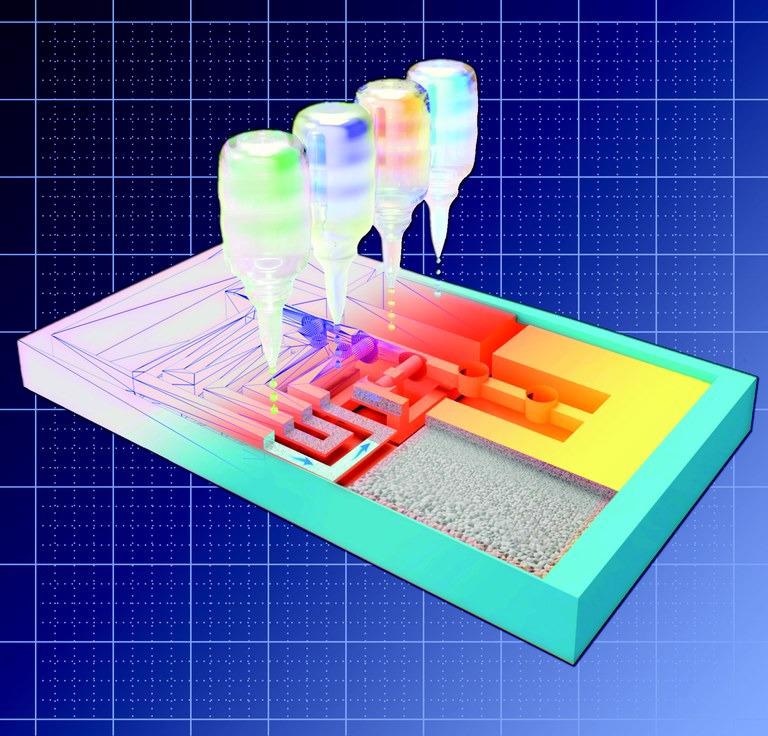May 11 2021
KU Leuven researchers have designed a new 3D printing method that expands the viabilities of lateral flow testing.
 Using a 3D printer, the researchers fabricated a 3D version of a lateral flow test. The basis is a small block of porous polymer, in which “inks” with specific properties are printed at precise locations. Image Credit: © Ameloot Group.
Using a 3D printer, the researchers fabricated a 3D version of a lateral flow test. The basis is a small block of porous polymer, in which “inks” with specific properties are printed at precise locations. Image Credit: © Ameloot Group.
Such tests are extensively used in the form of COVID-19 self-tests and the traditional pregnancy test. With the latest printing method, next-generation diagnostic tests can be developed that are fast, cost-effective, and user-friendly.
Due to the ongoing COVID-19 pandemic, everyone is aware of the significance of fast diagnosis. Since the end of March 2021, Belgium has permitted the sale of self-tests in pharmacies. This self-test is what is known as the lateral flow test.
With the help of a wiper, a specimen is collected via the nose and this is subsequently dissolved in a solvent and used on the test kit. The kit contains an absorbent material that shifts the specimen downstream and allows it to make contact with an antibody. In case a virus is present, a colored line will appear. The benefit of these tests is that they are cost-effective and do not need any dedicated appliances.
Lateral flow tests are handy for performing simple tests that lead to a yes and no response; however, these are not suitable for tests that need a multi-step procedure. This is the reason why KU Leuven bioengineers set out to design a new form of lateral flow test that has additional capabilities.
Precise Prints
The researchers used a 3D printer and created a 3D model of a lateral flow test. The foundation of this model is a tiny block of porous polymer, where “inks” with particular properties are printed at accurate places.
In this manner, a web of channels and tiny “locks” is printed that permit the flow through or impede it where and when needed, without the requirement for moving parts. At the time of the test, the specimen is automatically directed through the various steps of the test. This method helps follow even complex procedures.
The investigators assessed their method, recreating an Enzyme-Linked Immunosorbent Assay (ELISA) test, which is used for detecting immunoglobulin E (IgE). Ig E is quantified to diagnose allergies. In laboratory settings, this kind of test involves a number of steps, with a change in acidity and different rinses. The researchers successfully ran the whole process using a printed test kit resembling the size of a thick credit card.
Complexity is not a Cost
The great thing about 3D printing is that you can quickly adapt a test’s design to accommodate another protocol, for example, to detect a cancer biomarker. For the 3D printer, it does not matter how complex the network of channels is.
Dr Cesar Parra, KU Leuven
The new 3D printing method is also scalable and economical.
“In our lab, producing the Ig E prototype test costs about $ 1.50, but if we can scale it up, it would be less than $ 1,” added Dr Parra.
The new method not only provides opportunities for faster and cheaper diagnosis in developed nations but also in nations where there is a greater need for cost-effective diagnostic tests and where the medical infrastructure is not highly accessible.
At present, the researchers are developing their own 3D printer, which will be more flexible when compared to the commercial version employed in the new analysis.
An optimised printer is kind of like a mobile mini factory which can quickly produce diagnostics. You could then create different types of tests by simply loading a different design file and ink. We want to continue our research on diagnostic challenges and applications with the help of partners.
Bart van Duffel, Innovation Manager, KU Leuven
3D printing technique for lateral flow diagnostics
Video Credit: KU Leuven.
Journal Reference:
Achille, C., et al. (2021) 3D Printing of Monolithic Capillarity‐Driven Microfluidic Devices for Diagnostics. Advanced Materials. doi.org/10.1002/adma.202008712.